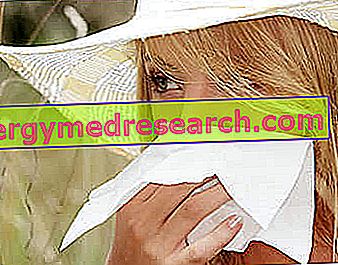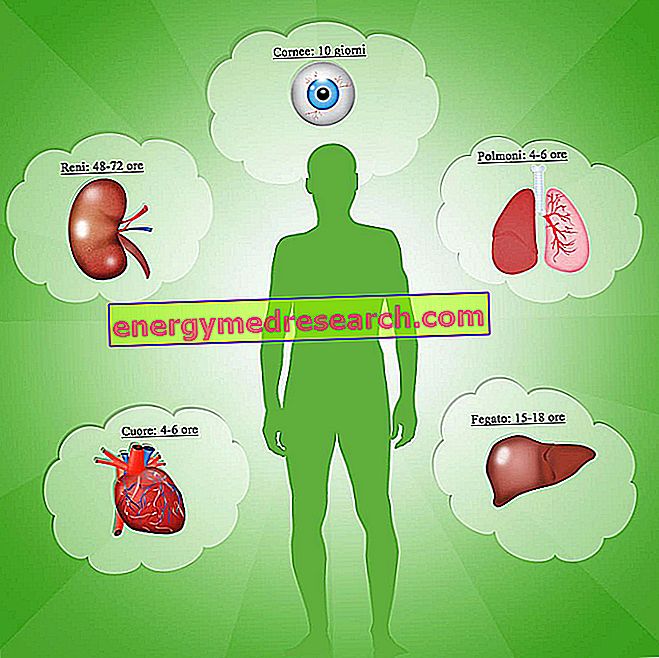Generality
Allergic asthma is an inflammatory disease of the respiratory system, caused by excessive reactivity to various allergenic stimuli (eg pollens, molds, dust mites or pet dander) present in the external environment.

The symptomatology of this condition is usually chronic or intermittent. In any case, the severity and variety of the manifestations are highly subjective, as they vary according to the person affected: asthma attacks can vary from a simple hiss to severe respiratory failure, which makes hospitalization necessary.
The diagnostic classification of allergic asthma is based on the history, physical examination and respiratory function tests.
The treatment involves the control of the triggering factors and the drug therapy, more commonly with bronchodilators, beta 2 agonists and inhaled corticosteroids.
What is an allergy?
An allergy is a condition characterized by an abnormal reactivity of the immune system towards one or more substances (called allergens ), present in the external environment and usually harmless to most individuals.
The body of allergic subjects recognizes these allergens as a danger and tries to fight them by producing a particular type of antibodies, called Immunoglobulins E ( IgE ).
The contact with the substance against which the sensitization has taken place causes a disproportionate defense mechanism on the part of the organism, which generates an inflammatory reaction which leads to various manifestations of the respiratory tract (eg asthma, rhinitis and nasal congestion), of the gastrointestinal tract (vomiting, diarrhea, etc.) or skin (such as hives).
In extreme cases, an anaphylactic shock occurs, a serious allergic manifestation that involves the whole body, causing, in particular, breathing difficulties and hypotension up to the loss of consciousness and death. Anaphylactic shock represents a medical emergency that requires immediate and adequate treatment.
Typical allergens are: pollen, dust mites, hair and saliva of cats and dogs, certain foods and drugs and poisons of some insects. In general, the greater the predisposition and the exposure to environmental allergens, the earlier the onset of the disease is.
Causes of allergic asthma
Allergic asthma is an inflammation of the bronchial tree, caused by exposure to allergens usually dispersed in the environment and harmless to healthy subjects; among the possible allergens, the most common are pollens, fur and dandruff from domestic animals, dust mites and molds.
Although there is no well-defined age of onset, the first "contact" with these substances generally occurs during childhood, especially in cases of family predisposition.
After this event, IgE production begins with the specific allergen in the patient. When the contact recurs, the sensitized subject undergoes an abnormal and excessive reaction of the immune system, from which follows a series of phenomena that affect the bronchi (indispensable structures for the passage of air in the lungs).
These events trigger, in particular, an inflammatory process against the respiratory tree, which alters its normal functionality: inflammatory cells (mast cells, eosinophils and lymphocytes) infiltrate the walls of the bronchi, in a more or less marked manner, making the walls thickened, edematous and hypersensitive ( hyperreactivity ) towards external stimuli, even minimal. Furthermore, the muscle cells that surround the airways can contract more or less violently, narrowing the bronchial lumen ( bronchospasm ). These mechanisms hinder the passage of air, causing the so-called "asthma attacks", recurrent episodes of respiratory crisis characterized by coughing, wheezing and chest tightness.
When asthma is not under control, prolonged exposure to the allergen causes chronic inflammation of the bronchi; in this case, an attack can also be triggered by physical exertion (asthma from exertion), by inhaling cold air or by a trivial viral infection.
Triggering and aggravating factors
In the etiology of asthma, in addition to causal factors, there are favoring and triggering elements .
There are several factors that determine the appearance of allergy:
- Hereditary predisposition;
- Environmental causes (eg exposure to inhaled allergens and chemical sensitizers in the air);
- Presence of other pathologies (allergic rhinitis, atopic dermatitis etc.).
Then there are agents that promote the appearance of allergic manifestations, such as:
- Tobacco smoke (also passive);
- Air pollution (nitrogen dioxide, particulate matter, aldehydes, etc.);
- Exposure to chemical substances (perfumes, insecticides, products for cleaning the house, etc.);
- Viral and bacterial respiratory infections;
- Smells and irritating gases (perfumes, hairsprays, ammonia vapors, paints and insecticides);
- Eating habits;
- Drugs.
Factors that can trigger an allergic asthma attack include:
- Exposure to irritating gases;
- Cold air;
- Physical exercise and intense efforts;
- Stress and strong emotions;
- Respiratory infections.
Signs and symptoms
In the presence of triggering factors, allergic asthma leads to inflammation of the airways, which leads to an involuntary and reversible contraction of the bronchial muscles (bronchospasm) and irregular lung ventilation.
The symptoms of allergic asthma vary from person to person, in frequency and severity, but generally include:
- Cough, initially dry and testy, which often precedes the actual asthmatic attack;
- Expectoration of thick and stringy mucus, particularly during the night and early morning;
- Sense of oppression at chest level;
- Dyspnoea (difficulty breathing);
- Wheezing (called "wheezing") characterized by noises (whistles and groans), especially in the expiratory phase, due to the considerably limited air flow;
- Sleep disorders;
- Difficulty to make physical efforts and, in the most serious forms, to carry out daily actions, such as climbing stairs, walking or inability to speak.
Generally, the signs and symptoms of allergic asthma are reversible with timely treatment.
Crises can be acute, chronic (persistent) or intermittent, even long after an episode and the other. The symptomatology disappears between one attack and another, even if in some asymptomatic patients there may be faint sounds during forced expiration, at rest or after physical exertion.
Diagnosis
The diagnosis of allergic asthma is formulated, first of all, taking into account the patient's clinical history (period and season of exposure to the allergen, occupation, lifestyle, eating habits, activities carried out in the free time, familiarity with allergy, presence of animals in the home etc.) and the characteristics of the attacks (when the symptoms first appeared, their nature and periodicity, the triggers already identified etc.)
The collection of anamnestic data must be integrated with a general examination (weight, blood pressure etc.), visit by the otolaryngologist (to exclude other pathological conditions), allergy tests and tests on respiratory functions .
In addition to the symptoms and anamnesis, the diagnosis of allergic asthma is formulated through:
- Spirometry to measure lung capacity;
- Respiratory function tests to assess the degree of bronchial obstruction and its reversibility;
- Skin allergy tests (Prick test);
- Serological tests for immunoglobulin research (specific IgE research) responsible for the allergic reaction and for the recognition of the responsible allergen (Rast test);
Allergic asthma can also be diagnosed through more specific tests, such as:
- Bronchial provocation test for the measurement of nitric oxide present in the emitted air (exhaled), which indicates the level of inflammation;
- Imaging diagnostics, such as radiographs and computerized tomography, ie investigations that can highlight abnormalities of the lungs and airways in general;
- Bronchial provocation test with methacholine (simulates the arrival of a stimulus that causes asthma);
- Sputum examination;
- Peak expiratory flow measurement;
- Arterial blood gas analysis.
Treatment
Asthma is a chronic disease that cannot be cured, but can be treated and kept under control quite effectively, allowing the patient to live a fairly normal life.
The treatment depends very much on the severity of the symptoms, on the age, on the duration of the pathology and on the presence of other diseases (eg colds, rhinosinusitis, obesity etc.) which can aggravate the seizures.
The first intervention consists in avoiding, when possible, the allergens responsible for the pathology.
The narrowing of the airways is reversible both spontaneously and with the aid of drug therapy.
In case of ongoing crisis, but not only, allergic asthma is treated with bronchodilator drugs and corticosteroids, sprayed through inhaler dispensers or systemically administered, depending on the severity of the clinical picture. The same drugs can effectively control symptoms, if used correctly and continuously. In any case, the dosage and therapeutic regimens are indicated by the doctor.
Antileucotrienes are a class of drugs for oral use that can help to quickly relieve the symptoms of asthma, but, unlike other molecules, they have greater side effects.
Prevention
Prevention is an essential weapon for controlling allergic asthma and consists of precautionary measures to avoid contact with allergens that can trigger an attack.
- In general, it is important to observe frequent cleaning of domestic and work environments, paying attention to armchairs, sofas, carpets, heavy curtains, pillows, beds and linen.
- Open the windows to ventilate the closed rooms, in particular when there are strong smells, fumes or vapors; avoid the formation of condensation and mold.
- Outdoors, on the other hand, it is useful to cover your mouth and nose with a scarf if it is cold or a mask in hot weather or if the place where you stay is particularly polluted (for example: very busy road or near factories and meadows) .
The doctor may also recommend specific immunotherapy with allergenic extracts (ITS or desensitizing therapy ). This approach allows you to gradually modulate the immune response typical of the allergic reaction, reducing the number and intensity of acute episodes. Specific immunotherapy involves daily administration under the allergen's tongue (eg grasses, parietaria, etc.), towards which the subject is to be de-sensitized. After a first phase, called induction, in which the dose is progressively increased, the maximum tolerated quantity is continued to be administered one to three times a week ( maintenance phase). The therapy lasts for approximately 3-4 years. The effects of desensitizing therapy are generally long lasting and significantly improve patients' quality of life.
Recommendations and precautions
- Consult an allergist / immunologist to establish a treatment plan appropriate to your case and to undergo regular checkups;
- Avoid environments where allergens to which you are sensitive are present;
- Absolutely avoid smoking (even passive);
- Use masks or a scarf to protect the airways;
- Avoid sudden and intense physical exertion.



